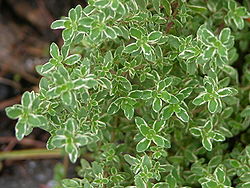Greek name and pronunciation:
Thymari, θυμάρι, pronounced thee-MAH-ree (soft th sound)
At the market:
Thyme is available both fresh and dried, and fresh thyme is much preferred in cooking. Dried thyme leaves are sold in disposable containers, and fresh thyme is sold in bundles. Thyme is also a good choice for a kitchen herb garden.

Thyme – Thymari
Physical characteristics:
Varieties of this perennial undershrub have woody and fibrous roots, with numerous round, hard, and branched stems, usually 4 to 8 inches long. The narrow elliptical leaves are greenish-grey, 1/8 inch long and 1/16 inch wide. The conical flowers are pink and grow in whorls (rings) at the branch terminus. Flower petals are rectangular. The seeds are round and very small, about 170,000 to the ounce.
Usage:
Thyme enhances the flavor of olive oil, pickled olives, butter, vinegar, meats, poultry, fish, soups and stews, and vegetable dishes. Fresh garden salads as well as stuffed baked vegetables benefit from the addition of thyme. It can also be added to breads, cookies, and spoon sweets.
Substitutes:
Many cooks recommend just leaving out any substitute, however in Greek cooking, oregano is often a good substitute.
Origin, History, and Mythology:
Gaius Plinius Secundus, (circa 23 – 79 A.C.E.), better known as Pliny the Elder, said that when thyme is burned, it “puts to flight all venomous creatures.”
In mythical folklore, thyme flowers were full of perfume and nectar for the bees, traditionally the messengers of the faery world. The bower of the Fairy Queen Titania in Shakespeare’s “A Midsummer Night’s Dream” is described as being in “…a bank where the wild thyme blows, where oxlips and the nodding violet grows…”.
Thyme is native to the Mediterranean, and historical records attribute, in part, the naming of the thyme plant to Theophrastus, 3rd century B.C.E. Greek philosopher and naturalist. Ancient Greeks believed thyme and its extracts could restore vigor and mental acuity. They burned it as a religious incense to give them courage. It was an ingredient in ritual altar fires, to purify the sacrifices to the gods. Thyme was burned as an incense at funerals and placed in the coffin of the dead in the belief that the soul of the deceased took up residence in the flowers of the thyme plant, and that thyme assured the passage of the deceased into the afterlife.

